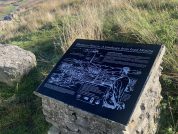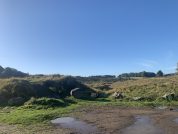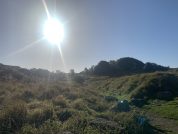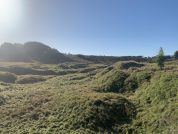Charterhouse Mine
Lead Mine and Silver Mine
The Roman Lead/Silver Mines at Charterhouse in the Mendip Hills south of Aquae Sulis (Bath, Avon), were operating from at least 49AD, as attested by dateable ingots of lead found in the neighbourhood of the Mendips (vide Burn 10/11 infra). At first the lead/silver industries were tightly controlled by the Roman military, but within a short time the extraction of these metals was contracted out to civilian companies (vide Burn 12 etiam infra), probably because the silver content of the local ore was not particularly high.
The Roman Settlement at Charterhouse
Little is known of the plan of the mining-settlement at Charterhouse-on-Mendip [44 VCH Somerset I, 1906, 334-344; see below, p. 123] (ST 502561). Besides the amphitheatre, photographs show broken ground marking old mining-operations and a rectangular earthwork (about 220 ft. by 200 ft.) with a wide entrance in the centre of the north-east side. Some structure seems to have stood within {93} the earthwork, and when opportunity comes for excavation at Charterhouse this would be a promising site at which to begin.
RIB 184 - Fragmentary funerary inscription
To the spirits of the departed (and) to …, her brother, Respecta his sister made this, … of … from Rome..
[...] AVG
[... ]VO RES
[...]ROR FECIT
[...]TVGENI
[... ]OMO ROMA
ORMIPS
IC R
6. The genitive -tugeni depends on either filia or uxor.
RIB 186 - Fragmentary inscription
No translation
NN[...]
RI[...]
FI [...]
No commentary.
RIB 185 - Fragmentary dedication
For the welfare of our Lord the Emperor-Caesar Marcus Aurelius Antoninus, son of the deified Lucius Septimius Severus Pius Pertinax, conqueror of Parthia, conqueror of Adiabene, ..
[... ... ] SEPTIMI [...]
[... ... ]I AD[...]
[ ...]
The occurrence of dominus and the spacing of the words suggest that the inscription commemorated Caracalla (A.D. 211-17) rather than Septimius Severus.
Claudian Lead Ingots from the Mendip Hills and Somerset
CIL-VII1201 - Lead pig from the Mendips
For Tiberius Claudius Caesar Augustus, High Priest, holding tribunician power for the ninth time, hailed Imperator in the field sixteen times. [Lead] from Britain.
Claudius held the powers of a tribune of the plebs for the ninth time from December 48AD until December the following year.
CIL-VII1202 - Lead pig from Somerset now in British Museum
British [lead]. For the Second Augustan [Legion] or For Britannicus Augustus,² the second [consignment?] • Veranius and Pompeius
Claudius was voted the honorific title Britannicus by the senate shortly after his return from Britain in 43AD, but instead chose to bestow that name upon his infant son. This entire line may also be translated: “British [lead]. For the Second Augustan [Legion]”. The translation given above is that favoured by Burn himself. Quintus Veranius and Caius Pompeius Longinus Gallus were ordinary consuls for the year 49AD (a.u.c.802).
CIL-VII1203 - Lead Ingot from Stockbridge in Hampshire, Probably Originating in the Mendips
For Nero Augustus, consul for the fourth time from the first of January. British [lead] • from the silver works of Gnaeus Pascius.
The emperor Nero was consul for the fourth time in 60AD (a.u.c.813), with Cossus Cornelius Lentulus his junior colleague. The mining contractor’s name may be Gaius Nipius Ascanius, who is thought to have had other interests at Pentre in North Wales.
More Lead Pigs from Charterhouse
There are other Roman lead/silver mines at Machen in Mid-Glamorgan, South Wales, Pentre in Flintshire, North Wales, and at Lutudarum (Crich, Derbyshire) in the Southern Pennines, where Tiberius Claudius Triferna is also known to have operated.
References for Charterhouse
- Chronicle of the Roman Emperors by Chris Scarre (Thames & Hudson, London, 1995);
- Roman Britain – A Sourcebook by S. Ireland (Routlege, New York, 1986);
- Chronology of the Ancient World by E.J. Bickerman (Thames & Hudson, London, 1980);
- The Romans in Britain – An Anthology of Inscriptions by A.R. Burn (Blackwell, Oxford, 1969);
- The Roman Inscriptions of Britain by R.G. Collingwood and R.P. Wright (Oxford 1965).
- Air Reconnaissance of Southern Britain by J.K. St. Joseph in J.R.S. xliii (1953) pp.81-97;
Map References for Charterhouse
NGRef: ST501561 OSMap: LR172/182
Roman Roads near Charterhouse
Probable road: NE (20) to Aqvae Svlis (Bath, Avon) SE (12) to Shepton Mallet (Somerset)
Sites near Charterhouse Mine
- Charterhouse Settlement (0)
Major Settlement - Charterhouse Fort (0 km)
Auxiliary Fort - Charterhouse Amphitheatre (1 km)
Amphitheatre - Chew Park Roman Villa (7 km)
Villa - Pagans Hill Chew Stoke Temple (9 km)
Temple Or Shrine - Cadbury-Congresbury Hill Fort (11 km)
Iron Age Hillfort - Congresbury Temple Complex (11 km)
Minor Settlement, Pottery, Roman-Building, Suspected Romano-british Temple Or Shrine and Villa - Meare Lake Village (15 km)
Iron Age Settlement - Gatcombe Roman Settlement (15 km)
Industry and Minor Settlement - Glastonbury Lake Village (15 km)
Iron Age Settlement



